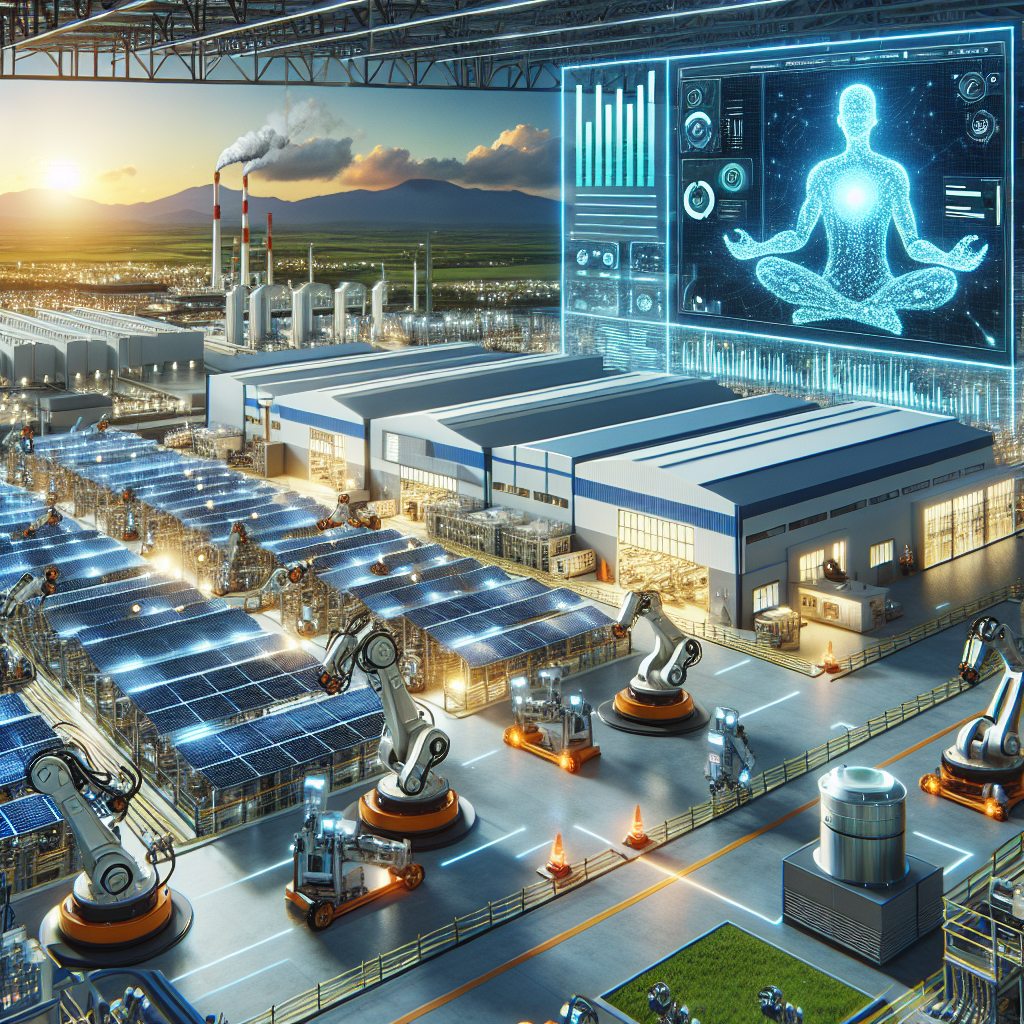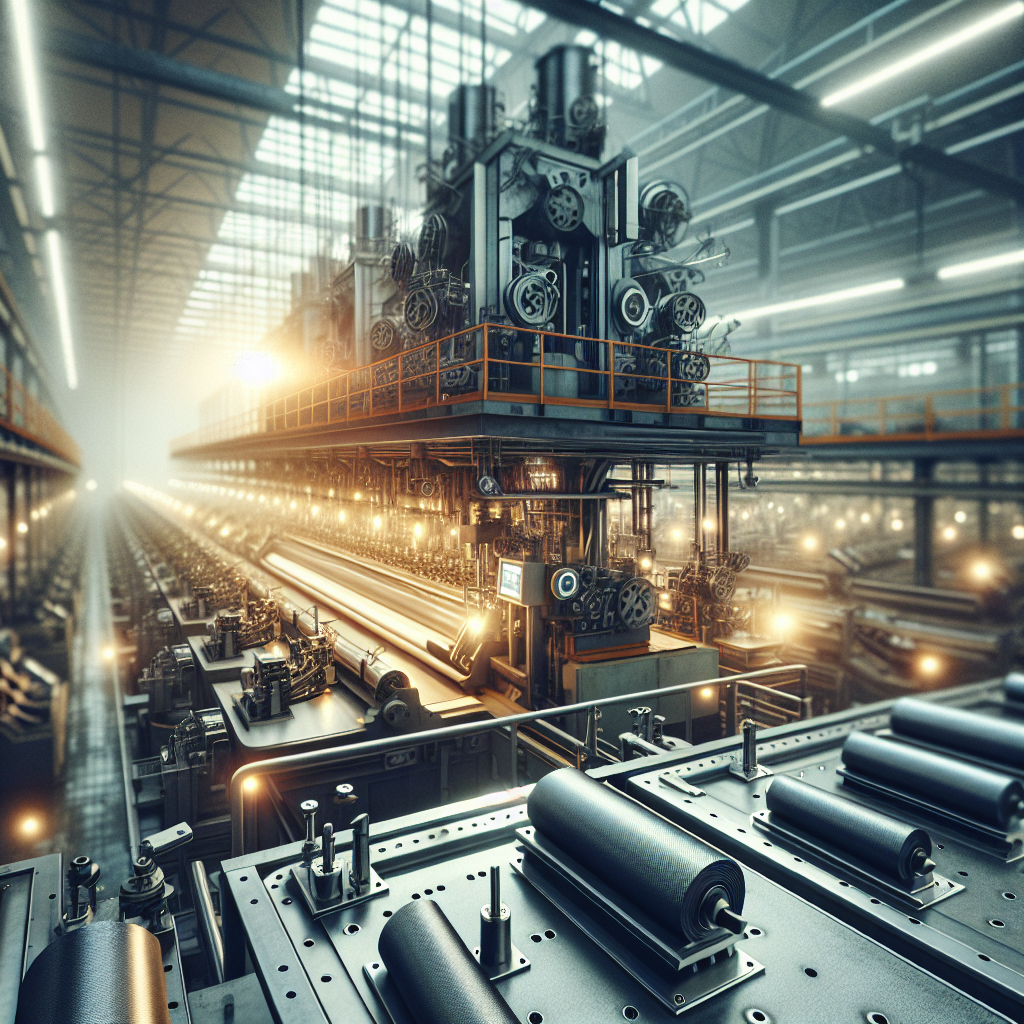The Role of AI in Sustainable Manufacturing
Sustainable manufacturing is becoming increasingly crucial in today’s environmentally conscious world. Artificial Intelligence (AI) plays a pivotal role in transforming how industries operate, particularly by enhancing sustainability. One of the primary contributions of AI is in improving energy efficiency. By utilizing advanced algorithms, AI systems can analyze vast amounts of data to optimize energy consumption in real time, thereby significantly reducing waste and operational costs. This not only helps in conserving energy but also in minimizing the carbon footprint of manufacturing processes.
Moreover, AI facilitates waste reduction through intelligent design and process optimization. By predicting potential points of failure or inefficiencies, AI can help manufacturers to make preemptive adjustments, thus minimizing material waste. This predictive capability extends to maintenance operations as well. With predictive maintenance, AI systems analyze data from machine sensors to forecast equipment failures before they occur, allowing for timely interventions that prevent downtime and equipment damage, further contributing to sustainable practices.
AI also plays a significant role in driving innovation within the manufacturing sector. By enabling the integration of smart technologies, such as the Internet of Things (IoT) and advanced robotics, AI fosters the development of more efficient production lines and smarter factories. This integration leads to enhanced production capabilities and fosters an environment where continuous improvement is possible. Furthermore, AI-driven insights can identify new opportunities for product innovation and development, thereby keeping companies competitive while adhering to sustainable principles.
| AI Application | Benefit |
|---|---|
| Energy Efficiency | Reduced energy consumption and carbon emissions |
| Waste Reduction | Minimized material waste and optimized resource usage |
| Predictive Maintenance | Decreased downtime and extended equipment life |
| Innovation | Enhanced production capabilities and product development |
Energy Efficiency Through AI
Artificial Intelligence (AI) is revolutionizing the way energy efficiency is approached in manufacturing processes. By integrating AI, manufacturers can optimize energy consumption patterns, leading to significant reductions in energy waste and operational costs. AI algorithms analyze vast amounts of data collected from various sensors across the manufacturing floor to identify inefficiencies and suggest improvements. This proactive approach allows for real-time adjustments that ensure energy is used optimally, aligning with sustainability goals.
One of the key benefits of AI in promoting energy efficiency is its ability to perform predictive analytics. Through AI-powered predictive maintenance, manufacturers can foresee potential equipment failures and address them before they occur, thus avoiding unplanned downtime and excess energy consumption. For instance, AI systems can predict when a machine is likely to consume more energy due to wear and tear, enabling timely interventions. This not only conserves energy but also extends the lifespan of the equipment.
The implementation of AI-driven energy management systems has also allowed for the development of smart grids within manufacturing facilities. These systems can autonomously adjust energy distribution based on real-time demand, ensuring that energy is not wasted in areas where it is not needed. For example, AI can dynamically allocate energy resources to high-demand areas while minimizing supply to zones with minimal activity. This intelligent allocation is made possible through continuous monitoring and data analysis.
| Energy Efficiency Benefits | AI Applications |
|---|---|
|
|
AI-Optimized Supply Chains
AI-Optimized Supply Chains are revolutionizing the way businesses approach manufacturing and distribution. By integrating AI technologies, companies can streamline their operations, resulting in enhanced efficiency and reduced environmental impact. One of the key areas where AI is making a significant difference is in the optimization of supply chains. AI algorithms analyze vast amounts of data from various sources to predict demand, manage inventory, and optimize logistics networks.
Predictive analytics is a powerful tool in AI-optimized supply chains. By using historical data and market trends, AI systems can accurately forecast demand and adjust production schedules accordingly. This minimizes overproduction and reduces waste, contributing to a more sustainable manufacturing process. Furthermore, AI can optimize transportation routes, reducing fuel consumption and carbon emissions. The result is not only cost savings for businesses but also a positive impact on the environment.
Another critical aspect of AI-driven supply chain optimization is inventory management. AI systems provide real-time insights into inventory levels, allowing manufacturers to maintain optimal stock levels and reduce excess inventory. This leads to fewer resources being tied up in unsold goods and decreases the likelihood of obsolescence. Additionally, AI can identify patterns and anomalies in supply chain data, helping companies to mitigate risks such as supplier disruptions or unexpected demand spikes.
| Benefits of AI-Optimized Supply Chains | Details |
|---|---|
| Energy Efficiency | Optimized transportation routes reduce fuel consumption. |
| Waste Reduction | Accurate demand forecasting minimizes overproduction. |
| Cost Savings | Improved inventory management reduces holding costs. |
| Risk Mitigation | AI identifies supply chain disruptions proactively. |
Waste Reduction and Resource Management
Waste reduction is a crucial component of sustainable manufacturing, and AI technologies are playing an increasingly vital role in optimizing this area. By leveraging advanced algorithms and machine learning models, manufacturers can now accurately predict waste generation patterns and implement effective strategies to minimize it. AI systems analyze production processes in real-time, identifying inefficiencies or excess material usage that contribute to waste. Through these insights, companies can adjust operations to reduce scrap rates and improve overall resource efficiency.
One effective approach is the use of smart sorting systems that utilize AI to differentiate between recyclable and non-recyclable materials. These systems enhance the precision of waste sorting, thus increasing the recycling rates and reducing the amount of waste sent to landfills. Furthermore, AI-driven resource management solutions enable manufacturers to optimize inventory levels, ensuring that raw materials and components are utilized efficiently. This not only reduces waste but also lowers costs associated with excess inventory.
The benefits of AI in waste reduction are further illustrated by the implementation of predictive maintenance practices. By predicting equipment failures before they occur, AI helps in reducing downtime and preventing the wastage of materials that might result from sudden breakdowns. A comparative analysis of traditional and AI-driven waste management strategies can be summarized in the following table:
| Aspect | Traditional Approach | AI-Driven Approach |
|---|---|---|
| Waste Identification | Manual inspection | Automated detection using sensors |
| Sorting Efficiency | Low | High with smart sorting systems |
| Predictive Maintenance | Reactive | Proactive with predictive analytics |
In conclusion, AI-driven waste reduction and resource management strategies are transforming sustainable manufacturing. By enhancing the accuracy and efficiency of waste management processes, AI not only helps to minimize environmental impact but also drives economic benefits for manufacturers. This technological advancement is crucial for achieving the dual goals of sustainability and innovation in the manufacturing sector.
Predictive Maintenance and Sustainability
Predictive maintenance is a critical component in the realm of AI-driven sustainable manufacturing, offering transformative potential to enhance both efficiency and sustainability. By leveraging advanced algorithms and machine learning techniques, manufacturers can predict equipment failures before they occur, effectively minimizing downtime and reducing maintenance costs. This proactive approach not only ensures the longevity of machinery but also significantly reduces the environmental impact associated with manufacturing processes.
The integration of predictive maintenance systems enables manufacturers to monitor equipment performance in real-time. This is achieved through the use of sensors and IoT devices that collect data on various operational parameters such as temperature, vibration, and pressure. The collected data is then analyzed using AI models to identify patterns and anomalies that indicate potential failures. By addressing these issues before they lead to equipment breakdowns, manufacturers can significantly reduce waste and energy consumption, thereby contributing to more sustainable operations.
In the context of sustainability, predictive maintenance plays a pivotal role in optimizing resource utilization. For instance, by ensuring that machinery operates at peak efficiency, manufacturers can lower their carbon footprint and reduce the consumption of raw materials. Moreover, this approach aligns with the principles of a circular economy, where the emphasis is on extending the lifecycle of products and minimizing waste. The following table illustrates the potential impact of predictive maintenance on sustainability metrics:
| Metric | Impact |
|---|---|
| Downtime Reduction | 30% Decrease |
| Waste Reduction | 20% Decrease |
| Energy Efficiency | 15% Increase |
| Carbon Footprint | 25% Reduction |
In conclusion, the adoption of predictive maintenance not only bolsters operational efficiency but also significantly advances sustainability goals. By preemptively addressing equipment issues, manufacturers can ensure continuous production flow, optimize energy usage, and minimize environmental impact. As a result, predictive maintenance emerges as a cornerstone of AI-driven sustainable manufacturing, driving both economic and ecological benefits.
AI-Powered Design Innovations
AI-powered design innovations are at the forefront of transforming the manufacturing industry, particularly in promoting sustainability. By leveraging advanced algorithms and machine learning, AI enables the creation of more efficient and environmentally friendly products. For instance, generative design software utilizes AI to explore all possible iterations of a design, optimizing for materials and energy efficiency. This process not only saves time but also reduces material wastage, thereby contributing to a significant reduction in the carbon footprint.
One of the key areas where AI is making a substantial impact is in predictive maintenance. AI systems analyze historical and real-time data to predict equipment failures before they occur, minimizing downtime and extending the life of machinery. This capability not only improves operational efficiency but also contributes to sustainability by reducing the need for new parts and equipment. The table below illustrates the potential reductions in maintenance costs and downtime achieved through AI-powered predictive maintenance:
| Metric | Traditional Maintenance | AI-Powered Maintenance |
|---|---|---|
| Maintenance Costs | High | Reduced by 20-30% |
| Downtime | Frequent | Reduced by 40-50% |
Furthermore, AI is driving innovation in material selection, which is crucial for sustainable manufacturing. AI algorithms can analyze a vast range of materials to determine the most sustainable options based on factors such as durability, recyclability, and environmental impact. This leads to the development of products that not only meet functional requirements but also align with sustainability goals. The integration of AI in material selection processes is paving the way for the next generation of sustainable products, as outlined in the following list of benefits:
- Enhanced product lifecycle through durable materials.
- Improved recyclability and reduced waste.
- Lower environmental impact through eco-friendly materials.
AI in Circular Economy Models
Artificial Intelligence (AI) plays a vital role in advancing circular economy models by facilitating the efficient use of resources and minimizing waste. In a circular economy, products and materials are reused, repaired, and recycled, creating a closed-loop system that reduces the need for new resources and limits environmental impact. AI enhances this model by optimizing processes through advanced data analytics and machine learning algorithms.
One of the key contributions of AI to the circular economy is in the area of predictive analytics. By analyzing vast amounts of data from production lines and supply chains, AI systems can predict when machinery is likely to fail or when maintenance is needed. This not only extends the life of equipment but also prevents unnecessary downtime, thus conserving resources and reducing waste. Moreover, AI-driven predictive maintenance helps in optimizing resource allocation and improving the overall efficiency of manufacturing processes.
AI also aids in material sorting and recycling. Advanced AI algorithms can accurately identify and sort different types of materials from waste streams, which is crucial for efficient recycling. This process is enhanced by machine learning models that continuously improve sorting accuracy over time. The impact of AI in recycling is evident in the increased recovery rates and the reduction of contamination in recycled materials, leading to higher quality and more sustainable end products.
Furthermore, AI supports the design of sustainable products by enabling more efficient and eco-friendly design processes. AI tools can simulate different design scenarios and assess their environmental impact, allowing designers to make informed decisions that prioritize sustainability. This not only leads to the creation of products that are easier to recycle but also reduces the carbon footprint associated with their production. Overall, AI-driven innovations in circular economy models are essential for promoting sustainability and achieving long-term environmental goals.
Real-Time Data for Sustainable Practices
Real-time data plays a critical role in advancing sustainable practices within the realm of AI-driven manufacturing. By harnessing the power of instantaneous data collection and analysis, manufacturers can make informed decisions that significantly enhance operational efficiency. Energy consumption, for instance, can be monitored continuously, allowing for immediate adjustments that minimize waste and reduce costs. This real-time feedback loop ensures that energy use is optimized, aligning closely with sustainability goals.
Moreover, real-time data facilitates predictive maintenance, which is essential for sustainable manufacturing. By analyzing data from machinery and equipment, AI systems can predict potential failures before they occur. This capability not only extends the lifespan of machinery but also prevents unexpected downtimes that can lead to resource wastage. Implementing predictive maintenance strategies based on real-time data allows manufacturers to maintain a high level of productivity while reducing the environmental impact associated with frequent equipment replacements.
The integration of real-time data also supports waste reduction by providing insights into production processes. By continuously monitoring inputs and outputs, manufacturers can identify processes that produce excessive waste and make necessary adjustments. For example, real-time data can highlight inefficiencies in material usage, prompting changes that reduce waste generation. This proactive approach not only conserves resources but also contributes to a more sustainable production cycle.
To illustrate the impact of real-time data, consider the following data points:
- Energy Efficiency Improvement: Real-time monitoring can lead to a 15% reduction in energy consumption by identifying peak usage times and adjusting operations accordingly.
- Predictive Maintenance Success: Implementing predictive maintenance can decrease machinery downtime by up to 20%, significantly reducing resource wastage.
- Waste Reduction Capability: Continuous monitoring can cut material waste by 25%, streamlining production processes.
Reducing Carbon Footprint with AI
Artificial Intelligence (AI) plays a pivotal role in reducing the carbon footprint of manufacturing processes. By leveraging AI algorithms, companies can optimize energy consumption and enhance operational efficiency, which are critical components in minimizing greenhouse gas emissions. For instance, AI can analyze vast datasets from production lines to identify patterns and suggest modifications that lead to energy savings. This not only lowers electricity use but also significantly reduces the carbon emissions associated with energy production.
Implementing AI in sustainable manufacturing involves several strategies. One approach is the use of predictive analytics to foresee equipment failures and schedule timely maintenance, thereby reducing downtime and energy waste. AI systems can also control and adjust heating, cooling, and lighting systems within manufacturing plants to operate only when needed, further conserving energy. Moreover, AI can assist in optimizing supply chains by predicting demand and adjusting production schedules, reducing the carbon emissions related to excess inventory and transportation.
Another impactful application of AI is in material optimization. AI-driven tools can analyze the entire lifecycle of materials used in manufacturing, from sourcing to disposal, and suggest alternatives that have a lower environmental impact. This not only helps in reducing the carbon footprint but also promotes the use of sustainable materials. Furthermore, AI can facilitate the development of new products and processes that inherently produce fewer emissions.
The integration of AI in manufacturing not only aids in reducing carbon emissions but also drives innovation. By continuously analyzing data and learning from it, AI systems can suggest innovative solutions that were previously unconsidered. This can lead to the development of new technologies and methods that further enhance sustainability in manufacturing. The table below highlights some key areas where AI contributes to reducing carbon footprints:
| AI Application | Impact on Carbon Footprint |
|---|---|
| Energy Optimization | Reduces energy consumption and associated emissions |
| Predictive Maintenance | Minimizes downtime and energy waste |
| Supply Chain Efficiency | Decreases emissions from transportation and excess inventory |
| Material Optimization | Promotes use of sustainable materials |
AI and Renewable Energy Integration
Artificial Intelligence (AI) plays a pivotal role in integrating renewable energy sources into manufacturing processes, significantly enhancing both efficiency and sustainability. By leveraging AI algorithms, manufacturers can optimize the use of renewable energy, such as solar and wind power, to meet their production demands. This not only reduces reliance on non-renewable energy sources but also minimizes the overall carbon footprint of the manufacturing process.
One of the primary benefits of AI-driven renewable energy integration is its ability to predict and manage energy consumption patterns. AI systems analyze historical data and real-time inputs to forecast energy needs, enabling manufacturers to schedule high-energy-consuming tasks during periods of peak renewable energy generation. This synchronization maximizes the use of available renewable energy and decreases dependency on fossil fuels.
Furthermore, AI facilitates the seamless integration of renewable energy storage systems, such as batteries, into manufacturing operations. By predicting energy demand and supply fluctuations, AI can optimize the charging and discharging cycles of these storage systems, ensuring that renewable energy is efficiently stored and utilized. This approach not only enhances energy efficiency but also contributes to cost savings by reducing energy waste.
Additionally, AI-driven systems are instrumental in identifying and mitigating potential disruptions in renewable energy supply. For instance, machine learning algorithms can detect patterns indicating potential equipment failures or adverse weather conditions that may affect energy generation. By providing early warnings, AI enables proactive maintenance and contingency planning, ensuring a steady and reliable supply of renewable energy for manufacturing needs.
Challenges and Opportunities in AI-Driven Manufacturing
The integration of AI into sustainable manufacturing presents both significant challenges and promising opportunities. One of the primary challenges is the high initial cost of implementing AI technologies. Many manufacturers face financial constraints, making it difficult to invest in the necessary infrastructure and training required for AI adoption. Furthermore, there is often a resistance to change within organizations, as employees may fear job displacement due to automation. This necessitates a focus on upskilling and reskilling the workforce to ensure a smooth transition.
Despite these challenges, the opportunities afforded by AI-driven manufacturing are substantial. AI can vastly improve energy efficiency by optimizing production processes and reducing energy consumption. This not only leads to cost savings but also contributes to environmental sustainability. Additionally, AI facilitates predictive maintenance, which minimizes downtime and extends the lifespan of machinery. By analyzing data patterns, AI systems can predict equipment failures before they occur, allowing for timely interventions.
Moreover, AI-driven manufacturing supports innovation through enhanced data analytics and process automation. The ability to quickly process and analyze large datasets enables manufacturers to identify trends and optimize production lines. This can lead to the development of new, more efficient manufacturing techniques and products. The reduction of the carbon footprint is another crucial benefit, as AI can help streamline operations and reduce waste.
To illustrate the impact of these opportunities, consider the following data on AI implementation in manufacturing:
| Aspect | Percentage Improvement |
|---|---|
| Energy Efficiency | 15% |
| Predictive Maintenance | 20% reduction in downtime |
| Waste Reduction | 25% |
| Carbon Footprint | 30% reduction |
The data highlights the transformative potential of AI in enhancing manufacturing efficiency and sustainability. As companies continue to embrace these technologies, it is crucial to address the challenges head-on while leveraging the numerous opportunities AI presents.
Case Studies of AI in Sustainable Manufacturing
Case Study 1: Siemens and Predictive Maintenance
Siemens has been at the forefront of integrating AI into its manufacturing processes, particularly through the implementation of predictive maintenance strategies. By leveraging AI algorithms, Siemens is able to anticipate equipment failures before they occur, significantly reducing downtime and maintenance costs. This approach not only enhances operational efficiency but also contributes to sustainability by extending the lifespan of machinery and reducing the need for resource-intensive repairs.
- Energy Efficiency: Predictive maintenance helps in optimizing energy usage by ensuring machines operate at peak efficiency.
- Waste Reduction: Minimized breakdowns lead to less waste generated from defective products and unused materials.
| Company | AI Application | Outcome |
|---|---|---|
| Siemens | Predictive Maintenance | Reduced Downtime by 30% |
Case Study 2: Tesla’s Energy Optimization
Tesla’s manufacturing facilities have utilized AI to enhance energy optimization. By analyzing data from various sources within the production line, AI systems can identify patterns and recommend adjustments to reduce energy consumption. This intelligent energy management approach not only decreases operational costs but also lessens the environmental impact by reducing the carbon footprint of manufacturing processes.
- Carbon Footprint Reduction: AI-driven energy management contributes to lower greenhouse gas emissions.
- Innovative Practices: Continuous AI analysis fosters innovation by identifying new energy-saving opportunities.
| Company | AI Application | Outcome |
|---|---|---|
| Tesla | Energy Optimization | Energy Costs Reduced by 20% |
Future Trends in AI and Sustainability
The future of AI in sustainable manufacturing is poised to revolutionize the industry through a myriad of innovative trends. Predictive analytics will become increasingly sophisticated, allowing manufacturers to anticipate equipment failures and maintenance needs with greater precision. This capability not only extends the lifespan of machinery but also minimizes downtime, which in turn enhances overall productivity. As AI models learn from vast datasets, their accuracy in predicting equipment malfunctions improves, leading to more efficient and sustainable operations.
Another promising trend is the integration of AI with the Internet of Things (IoT) to create smart factories. These intelligent environments use interconnected devices to gather real-time data, which AI systems then analyze to optimize manufacturing processes. For instance, sensors embedded in machinery can monitor energy consumption, enabling AI to suggest adjustments that reduce energy use and lower costs. As this technology evolves, the collaboration between AI and IoT will likely lead to even greater advancements in energy efficiency and resource management, further driving sustainability in manufacturing.
Moreover, AI is expected to play a crucial role in enhancing supply chain transparency. By employing AI algorithms to analyze data across the supply chain, manufacturers can identify inefficiencies and areas for improvement. This increased transparency not only helps in reducing carbon footprints but also ensures that sustainable practices are adhered to at every stage of production. Companies can thus maintain ethical sourcing and production standards, which are increasingly becoming a priority for consumers and regulatory bodies alike.
| AI Trend | Impact on Sustainability |
|---|---|
| Predictive Analytics | Reduces downtime and extends machinery lifespan. |
| AI and IoT Integration | Optimizes energy consumption and resource management. |
| Supply Chain Transparency | Enhances ethical sourcing and reduces carbon footprints. |



